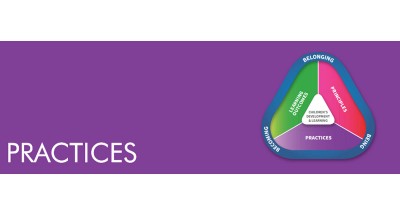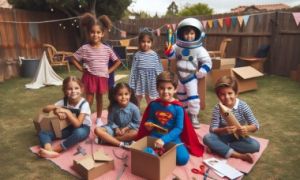The 8 Practices are supported by early childhood pedagogy's guiding principles. The following article provides details of each of the 8 Practices in the EYLF.
Holistic, Integrated and Interconnected Approaches
The integration and interconnectedness of all aspects of children's learning, development, and wellness are acknowledged by holistic approaches. When educators use a holistic approach, they consider the cognitive components of learning as well as the physical, personal, social, emotional, and spiritual welfare of the students. Since they are aware of how kids behave and believe that learning involves both the body and the mind, they encourage embodied learning.
Children's voices, actions, and movements are taken into account in great detail throughout planning and evaluation in this approach. Despite the fact that educators may choose to plan or evaluate with an emphasis on a certain learning outcome or component, they consider children's development as integrated and interconnected. They acknowledge the interconnections that exist between kids, families, and communities as well as the value of partnerships and reciprocal relationships in the learning process. They prioritise community involvement and collaborative learning because they view learning as a social activity.
Holistic approaches to learning and teaching are encouraged by educators. They comprehend how the Framework's components work together and how they are related to one another. The key to ensuring children receive a holistic education is the integration of the Vision, Principles, Practices, and Learning Outcomes. The ideas guiding their practises and the effects of their actions on children's engagement and achievement in learning, growth, and welfare are all considerations educators take into account while planning, instructing, and assessing learning.
The importance of ties to the natural world is another component of an integrated, holistic approach to teaching and learning. The ability of students to comprehend and respect the natural world, as well as the interdependence of humans, plants, animals, and the land, is fostered by educators.
Responsiveness To Children
Each child's qualities, capacities, and curiosities are recognised by educators, who respond in ways that best suit those characteristics. Children's motivation and engagement in learning are boosted when their abilities, skills, and knowledge are recognised, valued, and expanded upon. Teachers are aware of and responsive to the coping mechanisms employed by children with special needs to navigate daily life. They react to the knowledge and cultural practises and methods of knowledge of children, as well as to the many languages that some children, especially Aboriginal and Torres Strait Islander children, speak. Children's knowledge (experiences and understandings), ideas, sociality, and playfulness are also taken into consideration by educators when developing curricular decisions. Teachers evaluate, predict, and expand children's learning, development, and welfare in response to their changing ideas and interests by asking open-ended questions, offering feedback, pressing their thinking, and directing their learning. In order to respond in ways that foster relationships and enhance children's learning, development, and wellness, educators are attentive to and actively listen to children. They use both pre-planned and unplanned "teachable moments" to support kids' learning.
As educators and students collaborate to learn and make decisions while showing each other respect and trust, responsive learning partnerships are strengthened. Respect, educators can respectfully enter children's play and ongoing projects to encourage their thinking and bolster their learning through responsiveness.
Play-based Learning And Intentionality
Play-based learning methodologies support many forms of play and acknowledge the intentional roles that kids and teachers may play in kids' learning. Children develop relationships and friendships, test out ideas, challenge one other's thinking, and develop new understandings as they play with other kids and engage with adults. Children can ask questions, work out difficulties, and participate in critical thinking when they play because it provides both a context (a location or space where children can play) and a process (a manner of learning and teaching). Children have the chance to learn while they explore, create, improvise, and invent thanks to play-based learning.
Children's minds can be expanded and their desire to know and learn increased through purposeful play-based learning, which fosters favourable attitudes toward learning.
In play, children take deliberate action and have agency. Children's decisions about what to play with and who to bring into it serve as an example of this. Children who are fully immersed in their play, making plans, creating characters, solving issues, developing self-awareness, and learning how to socialise, negotiate, and think with others, stimulate neural pathways and connections in the brain. Children's engrossment in their play exemplifies how play encourages them to just be in the moment.
In order to enhance children's learning via play, educators are purposeful in all facets of the curriculum and behave carefully, thoughtfully, and purposefully. They understand that learning takes place in social situations and that learning requires shared attention, exchanges, conversations, and thought.
When educators use play-based learning, they are being intentional. For instance:
- Plan and design indoor and outdoor spaces that encourage and support various play activities for kids' active participation, agency, problem-solving, curiosity, creativity, and discovery.
- play a variety of parts in children's games or consciously choose when to watch, participate, and direct the activity.
- By employing deliberate teaching techniques like questioning, explaining, modelling, guessing, enquiring, and demonstrating, you may increase the knowledge, abilities, and love of thinking and learning in children.
- Through collaborative thinking and learning scaffolding, children's ideas and skills are sustained, extended, challenged, and deepened.
- design, record, and evaluate children's learning in play-based activities using a variety of methodologies.
- Plan and carry out worthwhile play-based learning activities based on the interests, piques, and knowledge of the kids.
- help young children recognise unfair play, and provide helpful suggestions for creating a loving, equitable, and inclusive learning environment.
- with children, be resourceful and courteous co-learners and collaborators.
- Encourage children's development of information, abilities, and concepts by carefully extending what they already know.
- Take note of very young children's intents as they explore, practise, and experiment through play, and interact with them in a caring manner.
- acknowledge children’s enjoyment and sense of fun and playfulness in learning, particularly when engaged in group play
- provide a balance between child-led and adult-initiated and guided play
- Organize opportunities for deliberate knowledge creation while also identifying and taking advantage of unplanned teaching and learning opportunities
- Utilize rituals, transitions, and routines to promote learning, growth, and wellbeing
- Participate in children's play activities, such as playing a role in pretend play, to better grasp and expand upon their concepts, which will promote and encourage learning.
- enhance children's multimodal play by integrating popular culture, media, and digital technologies.
Learning Environments
When educators incorporate physical, temporal, social, and intellectual factors into eLearning settings, they are acting intentionally in play-based learning. Indoor and outdoor learning environments that are warm, secure, and inclusive reflect, respect, and affirm the identities of children and families while enhancing their lives. The daily timetable for active and quiet play is planned and provided by educators, who also provide both calm and active locations. They offer spaces for both individuals and groups that take into account the talents and interests of the kids. Environments that promote learning are lively, adaptable areas that take into account the talents, cultures, languages, hobbies, and strengths of each child as well as certain facets of the local community. Well-designed environments allow for acceptable modifications where necessary and adapt to various learning styles and capacities.
Australian learning settings include outdoor learning areas. They provide a wide range of opportunities for physical activity and educational opportunities that are not available indoors. Access to play areas in undeveloped areas may include vegetation, trees, vegetable gardens, open areas, sand, rocks, mud, water, and other natural components. These and other outdoor areas encourage spontaneous, risk-taking play and relationships as well as investigation, discovery, and a connection to nature. They also encourage physical activity and play. They encourage respect for the natural world and the interdependence of humans, animals, plants, lands, and seas while giving kids the chance to interact with all sustainability ideas through environmental education.
Wherever possible, educators engage in learning about Country and provide opportunities for kids to learn more about Aboriginal and Torres Strait Islander links to and relationships with Country. Learning about and from the country is beneficial for all kids. Children of Aboriginal and Torres Strait Islander descent have a strong spiritual connection to their country. It can be seen in their interactions and communication with their communities, families, kinship systems, and ancestors. It is in their relationship with the trees, waterholes, and mountains on the land.
Both indoor and outdoor settings encourage dialogues between kids, teachers, families, and the larger community while supporting all facets of children's development. They encourage chances for ongoing group discussion and cooperative education. For best learning results, children should spend sustained, appropriate amounts of time both indoors and outside. The availability of resources and how learning spaces are organised may permit some children to participate while preventing others, according to approved providers and educators. Approved service providers and instructors take care of every aspect of the environment in this way to encourage participation, academic success, and the growth of positive self-worth in all children.
Materials that represent the natural and familiar while introducing innovation to spark curiosity and encourage more sophisticated and increasingly abstract thought to improve learning. Digital media and technologies, for instance, can give kids access to worldwide connections and resources and promote innovative thinking. Environments and resources can also emphasise our obligations for a sustainable future and help kids realise their obligation to take care of others.
regarding the environment. They can encourage optimism, awe at the natural world, awareness of it, and consideration of social and economic sustainability.
Children and families can offer ideas, interests, and questions to the learning environment by being encouraged by educators. By making time for meaningful connections, offering a variety of possibilities for individual and shared experiences, and identifying opportunities for kids to actively participate in and contribute to their local community, they may encourage kids' involvement.
Cultural Responsiveness
educators who are sensitive to different cultural ways of knowing, acting, and being, and who welcome the advantages of variety. In the face of injustice or discrimination, they respect diversity and take appropriate action. A sincere commitment to incorporating Aboriginal and Torres Strait Islander viewpoints into every facet of the curriculum is part of being culturally responsive. Respecting and cooperating with children and families from varied cultural and language backgrounds is another aspect of being culturally sensitive. When educators show a persistent commitment to expanding their own cultural literacy through a three-way process involving children, families, and communities, this is an example of cultural responsiveness in action.
Teachers believe that a child's sense of identity, belonging, and achievement in lifelong learning are strongly influenced by their culture and the environment of their family and the larger community. By acting in the face of injustice and discrimination, they help kids become culturally aware and responsive. To create environments that are culturally safe and secure, educators work in partnership with kids, their families, and community members. They then utilise this knowledge to guide their practice.
Being sensitive to cultural variations is only one aspect of cultural responsiveness. It entails gaining knowledge of many viewpoints and variety in all of its manifestations, including that of Aboriginal and Torres Strait Islander peoples as well as racial, ethnic, cultural, linguistic, familial, and personal diversity. It is the capacity to comprehend, communicate with, and work well with persons from different cultural backgrounds. Cultural sensitivity includes:
- awareness of one's own biases and worldview
- sensitivity to different cultures
- respect for the traditions of the nation's traditional landowners, the Aboriginal and Torres Strait Islander people.
- learning about cultural customs and worldviews
- speaking with individuals compassionately and efficiently while acknowledging different cultural norms and communication styles
- daily habits, including rituals and routines
- decisions and behaviours that are sensitive to the context of children and families.
Culturally sensitive teachers are:
- aware of the circumstances surrounding each child and family
- actively working to include Aboriginal and Torres Strait Islander viewpoints into every facet of the curriculum
- using anti-bias strategies, such as social justice strategies, to combat racism and bias in the environment and community.
- incorporating democratic and ethical behaviour into their environment, emphasising the value of being a good citizen;
- encouraging kids to respond culturally when they encounter injustice or discrimination
- working together to create culturally safe learning environments with coworkers, kids, families, and their communities.
Continuity Of Learnnig And Transitions
In early childhood settings, children offer their own, familial, and communal ways of being, belonging, and becoming, also known as funds of knowledge. Children who feel secure, confident, and linked to familiar people, places, events, and understandings benefit from educators who are aware of and build upon their foundation of knowledge. Each child's sense of belonging is strengthened by this. Children, families, educators, and school teachers all help children make smooth transitions between environments.
As children go from one environment to another, their identities shift. When a kid transitions to a new room in their early childhood setting or starts full-time school, for instance, or when their status or identity changes, educators help the child negotiate these changes. As children undergo significant transitions to new environments (including school), early childhood educators
Transitions can occur often between routines, play areas, or environments as well as more significant ones, such as leaving home to begin school or an early childhood facility or switching from one early childhood setting to another. Every transition has chances and difficulties. Different locations and spaces have their own goals, standards, and procedures. Teachers make sure that every child takes an active part in preparing for transitions by working with kids and families. They help kids feel at ease with the process of change and help them comprehend the customs, rituals, and practises of the new environments they are going to.
From one context to the next, children should encounter consistent or comparable methods of being, performing, and learning. More continuity encourages successful transitions that go smoothly. Teachers communicate with families to promote continuity. For instance, ensuring smooth transitions requires an awareness of kinship structures, parenting practises, and other components of Aboriginal and Torres Strait Islander children's cultural existence. For families and kids alike, continuity between the early childhood facility and the home is crucial. By having conversations, providing access to routines and resources that are familiar, and providing timetables that permit greeting and farewell rituals, continuity in the transition to school can be facilitated. When moving into an early childhood facility or a school, certain families and kids will require greater help. To facilitate a smooth transition, educators work cooperatively with each child's new educator, classroom teachers, and other professionals.
Assessment And Evaluation For Learning, Development and Wellbeing
Evaluation and assessment are steps in a continuous cycle that also involves observation, documentation, analysis, planning, implementation, and critical reflection. The term "assessment" describes the process of gathering data over time using a variety of methodologies about children's learning, development, and well-being. The term "evaluation" refers to educators' critical reflection and analysis of this data as well as their assessment of the success of their curriculum preparation and execution. In conjunction with students, families, and other professionals, educators create short- and long-term learning goals for each child based on assessment and evaluation data.
Assessment
For a variety of reasons, educators choose their assessment methods. Observations, documentation, reflections, and information collection about and with children and their families are some assessment procedures. In order to take into account the children's accomplishments, capacities, and welfare in relation to the Learning Outcomes, educators describe and analyse the children's behaviours, interactions, and communications through assessment. The value of including children's opinions and contributions into assessment is recognised by educators. Each child's talents, strengths, and competencies will be recognised through assessment procedures that are all-inclusive, culturally and linguistically relevant, and sensitive to their individual physical, emotional, social, intellectual, and regulatory capacities. Through evaluation, teachers acknowledge and applaud not only the significant strides that kids make in their learning but also the incremental ones.
The three main methods of assessment used by educators.
- Formative assessment usually referred to as assessment "for children's learning," is the process of gathering and analysing data on what children already know, can do, and comprehend in order to inform pedagogy and planning. To gather detailed and insightful data that shows children's learning in context describes their progress and reveals their strengths, learning dispositions, talents, and understandings, educators employ a range of ways. When used properly, formative assessment tools can document the various learning paths that kids take and make the learning process apparent to kids, their families, teachers, and other professionals.
- The summative assessment also referred to as the assessment "of children's learning," occurs when educators assess children's abilities and accomplishments at predetermined or chosen time points, such as during their entry into an early childhood setting, in the middle of the year, or in preparation for their entry into a formal educational setting. To demonstrate the 'distance travelled' by learners, educators make expert judgements about students' learning progress over time. Using summative evaluations, educators can critically evaluate how students have interacted with more difficult concepts and participated in more advanced learning activities.
Summative evaluations can also be based on when kids reach developmental milestones, which is beneficial if teachers are worried about a kid's well-being or learning potential. With the help of this information, educators can engage families in conversation and even refer them to other specialists for diagnostic evaluation. - Children's awareness, participation, and appreciation of their own learning are facilitated by assessment "as learning." Using techniques like "talking and thinking floor books" or child portfolios, educators can record children's voices and contributions to assessments while also involving kids in recording their own learning. Children can use this to reflect on their learning and discover more about themselves as learners, as well as what and how they learn best.
- New insights that would not be feasible if educators only used their own perspectives can arise when children, families, and other professionals are involved in the formulation and execution of relevant and suitable assessment processes. With the support of the children and their families, educators, families, and children can better understand the assessment results by developing inclusive assessment techniques. Collaboration between assessment and families can help families act on behalf of their children both inside and outside of the early childhood setting and improve children's learning.
Evaluation
As part of the planning cycle, evaluation practises involve educators critically reflecting on how well they develop and implement curriculum for children's learning, both for and with children. Obtaining feedback from families can also be a part of evaluation procedures. The evaluation focuses on enhancing practice elements that will enhance children's learning, such as teaching and assessment methods, the environment, resource utilisation, and time management. Through techniques including peer review and discussion, observing others teach, coaching and mentoring, and professional journaling, educators can conduct evaluations and critical reflection.
When educators ask questions regarding novel ways of thinking and acting in their evaluations, such as "How effective, meaningful, and relevant was the planned programme?" and "What difference did we make, and for whom?" they are engaging in critical reflection.
- The chances, resources, approaches, and environments they provide, as well as how these connect to the targeted learning outcomes.
- How effectively learning opportunities, environments, and experiences are offered for children, as well as the strategies employed to promote their learning
- their awareness of and appreciation for the culturally specific knowledge about children and learning that is ingrained in the area where they are working.
- Each child's education is set in the context of their families and their own knowledge base, allowing the learning opportunities and experiences offered to build on the knowledge that each child brings to the early childhood environment.
- exposing implicit prejudices and assumptions about how children should be educated and what is expected of them
- using instructional techniques that are all-inclusive, appropriate for every child or small group of kids, demonstrate a knowledge of other people's perspectives, encourage kids' wellbeing, and foster effective learning.
Early childhood educators can evaluate their performance, identify gaps and goals, and learn from their errors. Teachers consider ways to expand on their achievements and adapt their teaching strategies.
Further Reading
EYLF Learning Outcomes Version 2.0 - The following articles provide a list of the 5 EYLF Learning Outcomes and their sub-outcomes (Version 2.0).
EYLF Outcome 1 - Child Have A Strong Sense Of Identity V2.0 - The following lists the sub outcomes, examples of evidence when children can achieve each sub outcome and how educators can promote and help children to achieve EYLF Learning Outcome 1: Children Have A Strong Sense Of Identity V2.0.
EYLF Outcome 2 - Children Are Connected With And Contribute To Their World V2.0 - The following lists the sub-outcomes, examples of evidence when children achieve each sub-outcome and how educators can promote and help children to achieve EYLF Outcome 2 - Children Are Connected With And Contribute To Their World V2.0.
EYLF Outcome 3 - Children Have A Strong Sense Of Wellbeing V2.0 - The following lists the sub-outcomes, examples of evidence when children achieve each sub-outcome and how educators can promote and help children to achieve EYLF Outcome 3 - Children Have A Strong Sense Of Wellbeing V2.0.
EYLF Outcome 4 - Children Are Confident And Involved Learners - The following lists the sub-outcomes, examples of evidence when children achieve each sub-outcome and how educators can promote and help children to achieve EYLF Outcome 4 - Children Are Confident And Involved Learners V2.0.
EYLF Outcome 5 - Children Are Effective Communicators V2.0 - The following lists the sub-outcomes, examples of evidence when children achieve each sub-outcome and how educators can promote and help children to achieve EYLF Outcome 5 - Children Are Effective Communicators V2.0.
Principles Of The EYLF Version 2.0 - The Principles serve as the foundation for a practice that is geared toward helping all children progress with respect to Learning Outcomes. The following article provides details of each of the 8 Principles in the EYLF.
Reference:
The Early Years Framework For Australia, ACECQA







 Here is the list of the EYLF Learning Outcomes that you can use as a guide or reference for your documentation and planning. The EYLF
Here is the list of the EYLF Learning Outcomes that you can use as a guide or reference for your documentation and planning. The EYLF The EYLF is a guide which consists of Principles, Practices and 5 main Learning Outcomes along with each of their sub outcomes, based on identity,
The EYLF is a guide which consists of Principles, Practices and 5 main Learning Outcomes along with each of their sub outcomes, based on identity, This is a guide on How to Write a Learning Story. It provides information on What Is A Learning Story, Writing A Learning Story, Sample
This is a guide on How to Write a Learning Story. It provides information on What Is A Learning Story, Writing A Learning Story, Sample One of the most important types of documentation methods that educators needs to be familiar with are “observations”. Observations are crucial for all early childhood
One of the most important types of documentation methods that educators needs to be familiar with are “observations”. Observations are crucial for all early childhood To support children achieve learning outcomes from the EYLF Framework, the following list gives educators examples of how to promote children's learning in each individual
To support children achieve learning outcomes from the EYLF Framework, the following list gives educators examples of how to promote children's learning in each individual Reflective practice is learning from everyday situations and issues and concerns that arise which form part of our daily routine while working in an early
Reflective practice is learning from everyday situations and issues and concerns that arise which form part of our daily routine while working in an early Within Australia, Programming and Planning is reflected and supported by the Early Years Learning Framework. Educators within early childhood settings, use the EYLF to guide
Within Australia, Programming and Planning is reflected and supported by the Early Years Learning Framework. Educators within early childhood settings, use the EYLF to guide When observing children, it's important that we use a range of different observation methods from running records, learning stories to photographs and work samples. Using
When observing children, it's important that we use a range of different observation methods from running records, learning stories to photographs and work samples. Using This is a guide for educators on what to observe under each sub learning outcome from the EYLF Framework, when a child is engaged in
This is a guide for educators on what to observe under each sub learning outcome from the EYLF Framework, when a child is engaged in The Early Years Learning Framework describes the curriculum as “all the interactions, experiences, activities, routines and events, planned and unplanned, that occur in an environment
The Early Years Learning Framework describes the curriculum as “all the interactions, experiences, activities, routines and events, planned and unplanned, that occur in an environment


